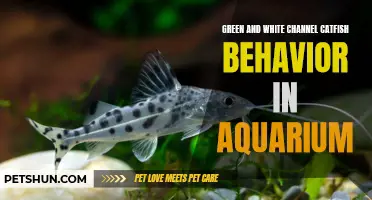
Are you a fan of unique and fascinating pets? Look no further than the transparent catfish! This remarkable creature is not only mesmerizing to look at but also relatively easy to care for. In this guide, we will explore all the essentials of transparent catfish care, including their tank requirements, diet, and maintenance. Get ready to dive into the captivating world of transparent catfish and learn how to provide them with the optimal conditions for a healthy and happy life.
| Characteristics | Values |
|---|---|
| Scientific Name | Kryptopterus bicirrhis |
| Common Names | Asian glass catfish, Ghost catfish |
| Difficulty Level | Easy |
| Minimum Tank Size | 20 gallons (75 liters) |
| Temperature Range | 72-82°F (22-28°C) |
| pH Range | 6.0-7.5 |
| Water Hardness | Soft to medium |
| Lifespan | 4-8 years |
| Size | Up to 6 inches (15 cm) |
| Diet | Omnivorous - prefers live or frozen food |
| Tank Setup | Heavily planted with hiding spots |
| Compatibility | Peaceful, suitable for community tanks |
| Behavior | Nocturnal, tends to hide during the day |
| Breeding Method | Egg scatterers, difficult to breed in captivity |
| Special Considerations | Sensitive to water quality, needs good filtration |
What You'll Learn
- What are the specific care requirements for transparent catfish?
- How often should transparent catfish be fed, and what type of food do they require?
- What water parameters are ideal for transparent catfish, and how should their tank be set up?
- Do transparent catfish have any special needs or considerations compared to other types of catfish?
- Are there any specific health issues or diseases that transparent catfish are prone to, and how can they be prevented or treated?

What are the specific care requirements for transparent catfish?
Transparent catfish, also known as glass catfish, are a popular species among aquarium enthusiasts. With their unique transparent bodies and peaceful nature, they make an interesting addition to any tank. However, like any other fish species, glass catfish require specific care requirements to ensure their health and well-being.
First and foremost, it is important to provide a suitable tank setup for your transparent catfish. These fish are known to be sensitive to water conditions, so maintaining a clean and stable environment is crucial. A tank size of at least 20 gallons is recommended, as these fish appreciate swimming space. It is also important to provide plenty of hiding spots and plants in the tank to mimic their natural habitat and give them a sense of security.
When it comes to water parameters, transparent catfish prefer slightly acidic to neutral water with a pH ranging from 6.0 to 7.5. The temperature of the water should be kept between 74 to 78 degrees Fahrenheit. It is essential to regularly test the water quality using a reliable test kit and perform regular water changes to maintain optimal conditions.
In terms of diet, glass catfish are omnivorous and will accept a variety of foods. Their diet should consist of a mixture of high-quality dry foods, such as pellets or flakes, as well as live or frozen foods such as bloodworms, brine shrimp, and daphnia. It is important to provide a balanced diet to ensure their nutritional needs are met.
When introducing transparent catfish into a new tank, it is advisable to acclimate them slowly to the new environment. This can be done by floating the bag containing the fish in the tank for about 15-20 minutes to allow the water temperatures to equalize. Afterward, you can open the bag and gradually add small amounts of aquarium water to the bag every few minutes. This will help the catfish adjust to the new water parameters without experiencing shock.
It is worth mentioning that transparent catfish are a shoaling species and should be kept in groups of at least 6 individuals. They are peaceful fish and can be kept with other peaceful species that are suitable for similar water conditions. However, it is important to avoid keeping them with aggressive or larger fish that may view the catfish as potential prey.
Regular observation of your transparent catfish is important to spot any signs of illness or stress. Look out for any abnormal behaviors, such as decreased appetite, lethargy, or visible signs of disease. In case of any issues, it is advisable to consult with a knowledgeable aquarium professional or veterinarian to determine the appropriate course of action.
In conclusion, providing suitable care for transparent catfish involves ensuring a clean and stable tank environment, maintaining proper water parameters, offering a balanced diet, and keeping them in suitable social groups. By meeting these specific care requirements, you can ensure the health and well-being of your transparent catfish in your aquarium.
Mastering the Art of Raphael Catfish Care: A Comprehensive Guide
You may want to see also

How often should transparent catfish be fed, and what type of food do they require?
Transparent catfish, also known as ghost catfish or glass catfish, are captivating creatures that can make a unique addition to any aquarium. Before bringing them home, it is important to understand their dietary requirements and how often to feed them for optimal health and well-being.
Transparent catfish are omnivorous, which means they eat both plant and animal matter. In their natural habitat, they primarily feed on small crustaceans, insects, worms, and algae. To replicate their natural diet in captivity, it is essential to provide them with a varied diet that includes both protein and vegetation.
When it comes to feeding frequency, transparent catfish should be fed small amounts of food multiple times a day. This mimics their natural feeding pattern and ensures they receive a constant supply of nutrients. Ideally, they should be fed three to four times a day, with each feeding session lasting for about five minutes. Overfeeding should be avoided, as it can lead to obesity and water quality issues in the aquarium.
As for the type of food, transparent catfish can be fed a combination of dry and frozen foods. High-quality pellets, flakes, and granules specifically formulated for omnivorous fish can serve as the staple diet. These foods usually contain a mix of proteins, carbohydrates, and vitamins to meet the nutritional needs of the fish. It is important to choose a food that sinks quickly, as transparent catfish are bottom-dwelling fish and prefer to feed near the substrate.
In addition to dry foods, it is essential to provide live or frozen foods to ensure a well-rounded diet for transparent catfish. They can be offered small live or frozen organisms such as brine shrimp, bloodworms, daphnia, and mosquito larvae. These foods not only provide essential proteins and nutrients but also simulate their natural feeding behavior.
To ensure a healthy diet, it is beneficial to rotate between different types of food. This helps prevent nutritional deficiencies and provides enrichment for the fish. However, any new food introduced should be fed in small quantities initially to monitor the fish's response and prevent overfeeding.
It is also worth mentioning that transparent catfish are social fish and should be kept in small groups of at least four to six individuals. Feeding them together not only encourages natural feeding behavior but also reduces stress and promotes a more harmonious environment.
In conclusion, transparent catfish require a varied diet consisting of both dry and live/frozen foods to thrive in captivity. They should be fed small amounts of food three to four times a day to mimic their natural feeding pattern. By providing a combination of high-quality pellets, flakes, and granules along with live/frozen foods like brine shrimp and bloodworms, you can ensure the optimal health and well-being of these captivating fish in your aquarium.
The Complete Guide to Pangasius Catfish Care for Beginners
You may want to see also

What water parameters are ideal for transparent catfish, and how should their tank be set up?
Transparent catfish, also known as glass catfish, are unique and intriguing freshwater fish that can make a great addition to your aquarium. To ensure their health and well-being, it is essential to provide them with the ideal water parameters and a proper tank setup. This article will provide you with all the necessary information to create a suitable environment for transparent catfish.
Water Parameters:
Transparent catfish are native to Southeast Asia, where they inhabit slow-moving rivers and streams with soft and acidic water. To mimic their natural habitat, it is important to maintain the following water parameters in their tank:
- Temperature: Ideally, the water temperature should be between 75°F and 82°F (24°C to 28°C). This range ensures that the catfish remain comfortable and can carry out their physiological processes effectively.
- PH Level: Transparent catfish prefer slightly acidic water with a pH range of 6.0 to 7.0. Regular monitoring of the pH level is crucial, as any significant fluctuations can be stressful for the fish.
- Hardness: These catfish prefer soft water with low mineral content. Ideally, the water hardness should be around 5 to 12 dH (degrees of hardness). You can achieve this by using filtered or RO (reverse osmosis) water.
- Ammonia, Nitrites, and Nitrates: It is essential to keep these water parameters at zero. Transparent catfish are sensitive to ammonia and nitrites, both of which are harmful to fish. Regular water testing and proper filtration are vital to maintain a healthy and stable nitrogen cycle.
Tank Setup:
Creating a suitable tank setup for transparent catfish requires careful consideration of their needs. Here are some key aspects to keep in mind:
- Tank Size: As these fish can grow up to 5 inches (13 cm), a minimum tank size of 20 gallons is recommended for a small group of catfish. Larger tank sizes can accommodate more fish and provide a more natural swimming space for this active species.
- Substrate and Decorations: A dark-colored substrate like sand or fine gravel mimics the natural environment of transparent catfish. It is also important to provide plenty of hiding places, such as driftwood, rocks, and plants. These hiding spots will help the catfish feel secure and reduce their stress levels.
- Lighting and Cover: Transparent catfish are sensitive to bright lights, and excessive exposure can cause stress. Use dimmed or subdued lighting in the aquarium and provide floating plants or tall decorations to create shaded areas.
- Water Flow: Transparent catfish prefer slow-moving water. You can achieve this by using a sponge filter or an adjustable filter that allows you to control the water flow. It is important to avoid strong currents, as they can stress out the catfish.
- Tank Mates: Transparent catfish are peaceful and can be kept in a community tank with other peaceful species. Avoid keeping them with aggressive or fin-nipping fish. Suitable tank mates include small tetras, rasboras, gouramis, and peaceful bottom-dwelling species like dwarf cichlids or Corydoras catfish.
In conclusion, transparent catfish require specific water parameters and tank setup to thrive. Providing them with the ideal temperature, pH level, hardness, and suitable tank decor will ensure their well-being. Remember to monitor water parameters regularly and maintain a stable environment to keep your transparent catfish healthy and happy.
The Ultimate Guide to Albino Cory Catfish Care
You may want to see also

Do transparent catfish have any special needs or considerations compared to other types of catfish?
Transparent catfish, also known as glass catfish, are a unique addition to any aquarium. These captivating fish have transparent bodies that allow you to see their internal organs and skeletal structure. While they may not have any specific special needs compared to other catfish species, there are a few considerations to keep in mind when caring for transparent catfish.
Firstly, it is important to provide adequate tank space for these fish. Transparent catfish can grow up to 4 inches in length, so a tank with a minimum of 20 gallons is recommended for a small school of these fish. They are peaceful and social animals, so it is best to keep them in groups of at least three to five individuals.
In terms of water parameters, transparent catfish thrive in well-maintained aquariums. The water temperature should range between 72 and 80 degrees Fahrenheit, with a pH level of 6.5 to 7.5. It is crucial to regularly monitor these parameters using a reliable water testing kit to ensure a stable environment for the fish.
Since transparent catfish have transparent bodies, it is essential to provide appropriate hiding places in the aquarium. These fish can be shy and may feel vulnerable without adequate hiding spots. Adding plants with broad leaves or driftwood can create shady areas for the fish to feel secure. Additionally, providing gentle water flow with the help of a sponge filter or air stone is beneficial, as it mimics their natural habitat.
Another consideration for transparent catfish is their diet. They are omnivorous and will eat a variety of foods. A balanced diet should consist of high-quality flake or pellet food supplemented with frozen or live foods such as bloodworms, brine shrimp, or daphnia. It is important to feed them small portions multiple times a day to prevent overeating and maintain their health.
It is worth noting that transparent catfish can be somewhat sensitive to water quality. Regular water changes and proper filtration are crucial for their well-being. Aim for weekly partial water changes of around 25% and ensure the filter is adequately sized for the tank to maintain water quality.
While transparent catfish are generally peaceful, they may occasionally nip at the fins of slow-moving fish. Therefore, it is best to keep them with species that are fast and active, such as tetras or rasboras. Avoid keeping them with aggressive or fin-nipping fish to prevent any potential issues.
In conclusion, caring for transparent catfish involves providing adequate hiding places, maintaining water parameters, providing a balanced diet, and ensuring proper tank size and companions. By meeting these needs, you can create a healthy and visually stunning environment for these captivating fish.
The Ultimate Guide to Black Devil Catfish Care: Tips and Tricks
You may want to see also

Are there any specific health issues or diseases that transparent catfish are prone to, and how can they be prevented or treated?
Transparent catfish, also known as glass catfish, are a popular addition to many aquariums. With their unique transparent bodies, they provide an interesting glimpse into the inner workings of a fish. However, like any other pet, transparent catfish can be prone to health issues and diseases. In this article, we will explore some of the common health issues that transparent catfish may face and discuss preventive measures and treatments.
One common health issue that transparent catfish may experience is fin rot. Fin rot is a bacterial infection that affects the fins of the fish. It is characterized by the deterioration of the fins, which may become ragged or frayed. Fin rot can be caused by poor water quality, stress, or injuries to the fins. To prevent fin rot, it is essential to maintain clean and well-filtered water in the aquarium. Regular water changes and the use of a good filtration system can help prevent this disease. If a catfish does develop fin rot, treatment typically involves improving water quality and using medications such as antibiotics or antifungal agents.
Another health issue that transparent catfish may encounter is swim bladder disease. The swim bladder is an organ that helps fish control their buoyancy and maintain their balance in the water. Swim bladder disease occurs when the swim bladder becomes damaged or infected, leading to problems with buoyancy and swimming ability. Symptoms of swim bladder disease in catfish include floating on the surface of the water or sinking to the bottom. The exact cause of swim bladder disease is not always clear, but it can be related to poor diet, constipation, or bacterial infections. To prevent swim bladder disease, it is important to provide a varied and balanced diet for the catfish. High-quality pellets, live or frozen foods, and occasional vegetable matter should be included in their diet. In cases of swim bladder disease, treatment may involve adjusting the fish's diet, providing a high-fiber food, or using antibiotics to treat bacterial infections.
Parasitic infections can also affect transparent catfish. One common parasite is Ichthyophthirius multifiliis, also known as ich. Ich is a protozoan parasite that causes white spots or small grains on the body and fins of the fish. Infected catfish may also exhibit scratching or rubbing against objects in the aquarium. To prevent ich and other parasitic infections, it is crucial to quarantine new fish before introducing them to the main tank and maintain good water quality. Treatment for ich usually involves raising the temperature of the water and using medication specifically designed to kill the parasite.
In addition to these specific health issues, transparent catfish can also be affected by general stress or poor water conditions. Stressors such as overcrowding, improper water temperature, or inadequate filtration can weaken the immune system of the catfish and make them more susceptible to diseases. Therefore, it is important to provide a suitable environment for the catfish, including appropriate tank size, proper water temperature, and good filtration. Regular water testing and maintenance can help prevent stress-related health issues.
In conclusion, transparent catfish, like any other fish, can be prone to various health issues and diseases. However, with proper preventive measures and prompt treatment, many of these issues can be mitigated or resolved. Regularly monitoring water quality, providing a balanced diet, quarantining new fish, and maintaining a stress-free environment are crucial for the overall health and well-being of transparent catfish in an aquarium. Consultation with a veterinarian or an experienced fish keeper is recommended if any health issues arise.
Caring for your Salmon Tail Catfish: A Comprehensive Guide
You may want to see also
Frequently asked questions
Transparent catfish should be fed 2-3 times per day. It is important not to overfeed them, as this can lead to health problems and poor water quality. Feed them a mixture of high-quality pellets and frozen or live foods, such as bloodworms or brine shrimp.
Transparent catfish thrive in well-maintained aquariums with clean and stable water conditions. They prefer a pH level between 6.5 and 7.5 and a temperature between 72-79°F (22-26°C). It is also recommended to provide a good filtration system and regular water changes to maintain optimal water quality.
Transparent catfish are generally peaceful and can be kept with other non-aggressive fish that are similar in size. However, it is important to note that these catfish have poor eyesight, so they may struggle to compete for food in a tank with more aggressive or fast-swimming fish. It is also best to avoid keeping them with any fish that may see them as potential prey.
Transparent catfish are a smaller species, typically reaching a maximum size of around 4-5 inches (10-12 cm) in length. This makes them a suitable choice for smaller aquariums, but it is still important to provide adequate space for them to swim and explore. It is worth noting that the size can vary slightly depending on the specific species of transparent catfish being kept.







